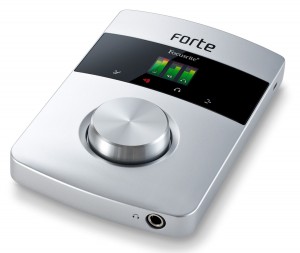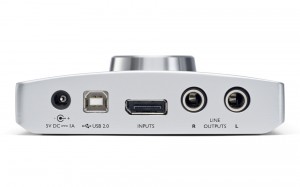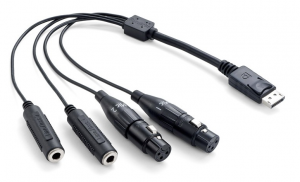Review: Focusrite Forte
Focusrite, once best known for their high-end Rupert Neve-designed consoles, have taken the entry-level interface market by storm in recent years.
Although they still make up-market professional products including the ISA range, the Control 2802 console and the RedNet system, it’s been their USB and Firewire interfaces in the Scarlett and Saffire series that seem nearly ubiquitous, claiming a space next to laptops and home desktops once reserved for Mboxes and M-Audio products. They’ve even branched into making one of the first ever interfaces for the iPad.
The Forte, however, is an entry in a relatively new, growing class of products designed to bridge that divide: It is meant to offer the compact cost-effectiveness of a small USB interface with the uncompromising specs of a true piece of professional-grade gear.
Just as Focusrite took a direct shot at a new market once dominated by Digidesign and M-Audio, they are now taking existing interfaces like the Apogee Duet and the RME Babyface head-on. They may not have invented the concept of the upscale small-format interface, but they have tried their best to refine it. And on some fronts, they’ve succeeded.
Features
One of the most unexpected – and perhaps most powerful – things about the Forte is its set of routing options.
At first glance, it appears to be a sleek and simple 2-in/2-out USB interface. But on closer inspection, it turns out to be a 2-in/4 -out interface.
And that’s not just counting the headphone jack on the front in addition to the balanced 1/4” connectors on the back. The Forte offers 4 actual channels of discrete DA conversion, meaning you can supply the headphones with a completely different mix than the speakers.
Adding to that, its microphone and line level inputs (accessible through a supplied breakout cable) can be sent to either of these destinations pre-conversion and pre-DAW. This input-monitoring option allows you to effectively kill any latency, regardless of how high you may need to set your buffer size on a dense mix as you tack on a last-minute overdub.
Neither of these are features you’re likely to find on any low-priced entry-level interface. Coupled together with a laptop, these options allow the Forte to provide some of the basic functionality of a real studio in an on-the-go setting.
With the help of a long headphone extender cable and an extra microphone, you could even set up something resembling a control room/live room situation in a hotel or house or conference room, providing latency-free monitoring as well as separate mixes for the performer and engineer and a discrete talkback channel. Not something you can do with just any 2-channel interface.
The Forte’s soft-touch buttons allow easy access to the most basic and regularly used features. Whatever isn’t accessible on the front panel is easily adjusted through a simple, uncluttered host application. The single scroll/push wheel that dominates the face of the Forte can even be assigned to provide DAW control functionality. Although I didn’t find the default “Play/Zoom” operation to be very useful (why would I need that when my spacebar and hot keys are right there?) switching to it to map to “Record/Shuttle” was kind of neat.
The box also comes with a small power supply and a variety of international adapters (it’s only needed if you want to supply phantom power or get extra, often unnecessary, levels of gain out of the unit) as well as an authorization for Focusrite’s “Midnight Suite” of plugins – a compressor and EQ based on the classic ISA 110 and 130 units. That last addition was a surprisingly nice one. An individual bypass for each band would have been a welcome addition to the EQ, but the sound and performance of each plugin easily exceeded expectations – especially for a $100 suite that’s being given away free-of-charge.
The Forte’s most significant features, however, are its specs. That’s what really separates it from down-market interfaces that are built to meet a lower price point. Signal-to-noise, THD, dynamic range, even preamp gain – a whopping 75dB of clean juice – easily outperform what’s available on the bulk of lower-cost options.
The Sound
The sonic goal of the Forte is hi-fi transparency, and there it succeeds. The preamps sounded big, clear, and clean with noise-free gain for days. It sounded more than good with a handful of condenser and dynamic mics, and even stood up to the notoriously low-gain Shure SM7 without any difficulty.
The quality of the headphone amp was another benefit. In a non-blind taste test it seemed just a bit more full, clear and open than the stock headphone amp in my MacBook Pro.
If the main 1/4” outs offered any discernible improvement over my home computer’s line outputs, it was less significant. But that isn’t a slight against the capabilities of the Forte – it’s an honest and positive appraisal of just how far consumer DA cards have come over the years. Today, many built-in outputs on high-quality computers stand up well to all but the finest (or most intentionally colored) DA converters on the market.
Build
The Forte is sleek, handsome, and felt solid enough to get the job done. On a visual level, it pairs nicely with the brushed aluminum of a Mac, even if it is just a quarter-of-a-shade off from being a perfect match. Focusrite also thought to make the unit compatible with PCs, which can’t be said for all the interfaces in this class.
My one critique is that the control wheel on my review unit had the slightest bit of intermittent friction. It was not noticeable whenever music was playing. But in a totally silent room I could hear and feel that one spot on the dial was ever-so-slightly sandpapery-feeling compared to the smooth operation throughout the other 359 degrees of rotation. This stood out to me only because the rest of the unit had such a well-appointed and perfectionist vibe. A representative from Focusrite assured us the company was aware that this had been an occasional issue on their first batch of Fortes, and that the issue had since been addressed.
The other thing I’d be careful of is the breakout cable. It’s not that it seems delicate, it’s just that it’s not great for a small desk like the one I use. The breakout cable prefers a firm flat surface underneath in order to deal with the gravity of the barrel connectors on its end. This is just fine if you have ample desk space, but on my compact monitor stand, this cable dangled off the back, and gravitational leverage tilted the front of the unit up into the air just slightly.
This issue could easily be solved with some creative strain relief or a more standard-sized desk, but it’s an element worth considering on these kinds of interfaces.
Summing It Up
The Forte is a worthy entry into this new field of small-footprint, high-performance interfaces for the home and travel.
Considering the ever-increasing quality of converters and headphone amps on good laptops, it might be overkill for anyone who just wants to do listening or work on some edits on the plane.
But for those who occasionally need to record a channel or two with high quality and no latency; for those who would benefit from the added routing options, or for those would just rest more comfortably knowing the monitoring path on their home system didn’t take any design shortcuts, the Forte is certainly a justifiable buy at $599.
Justin Colletti is a Brooklyn-based audio engineer, college professor, and journalist. He is a regular contributor to SonicScoop and edits the music blog Trust Me, I’m A Scientist.
Please note: When you buy products through links on this page, we may earn an affiliate commission.










Marco Raaphorst
January 17, 2013 at 6:49 am (12 years ago)“Considering the ever-increasing quality of converters and headphone amps on good laptops” I have to say the MacBook Pro headphone output sounds bad. Digital noise can be heard in the decaying of sound. It seems to be clean sometimes, but I believe some weird digital gate is used. It’s shitty as hell imo. Maybe the new Retina MBpro’s are differrent, don’t know.